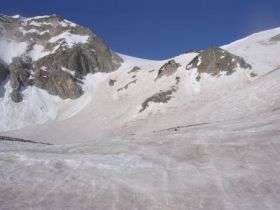Study shows desert droughts lead to earlier annual mountain snow loss

A new study spearheaded by the University of Colorado at Boulder’s National Snow and Ice Data Center indicates wind-blown dust from drought-stricken and disturbed lands in the Southwest can shorten the duration of mountain snow cover hundreds of miles away in the Colorado mountains by roughly a month.
Led by Tom Painter, the study found seasonal snow coverage in the sub-alpine and alpine areas of the San Juan Mountains of southwestern Colorado disappeared by about 30 days earlier in 2006 because of heavy dust deposition from the Colorado Plateau roughly 200 miles away. The dust, which probably came from northeast Arizona and northwest New Mexico deserts, reduced the snow’s reflectivity, allowing more of the sun’s energy to warm the snow pack and cause it to melt earlier.
“The connection between dust and lower snow reflectance is already established, but the amount of impact measured and modeled in this system stunned us,” said Painter. “The fact that dust can reduce snow cover duration so much – a month earlier -- transforms our understanding of mountain sensitivity to external forcings.”
While just three or four significant dust deposition events occurred annually in the San Juan Mountains between 2003 and 2005, eight occurred in 2006, according to the authors. In 2006, the sub-alpine regions of the San Juans melted out 24 to 35 days earlier than previous, relatively dust-free years, according to ground measurements and computer simulations.
A paper on the subject was published online June 23 in Geophysical Research Letters. Co-authors on the study included CU-Boulder’s Andrew Barrett, Jason Neff, Maureen Cassidy, Corey Lawrence and Lang Farmer, as well as Christopher Landry from the Center for Snow and Avalanche Studies in Silverton, Colo., and Kathleen McBride of Northern Arizona University.
The Colorado Plateau is centered in the Four Corners region of Colorado, New Mexico, Arizona and Utah and covers an area of roughly 130,000 square miles.
Prior to the widespread ecological disturbance of the Western U.S. in the late 1980s, the high mountain snow would have likely lasted several weeks longer in most regions, according to the researchers.
“Recent studies agree that with global warming, the Southwest will be warmer and drier,” said Painter. “Enhanced dust deposition is likely, further shortening snow cover duration. Ultimately, a warming climate and the dust it generates will affect river run-off and soil moisture in the mountains, not only in the Western United States but across many of the world’s mountains.”
Snowmelt provides drinking water to one-sixth of the world’s population and provides important agricultural and recreational resources for the Western United States, said Painter. The progression of climate change may alter the reliability of spring snowmelt, including its quantity, timing and duration, he said.
Source: University of Colorado at Boulder




















